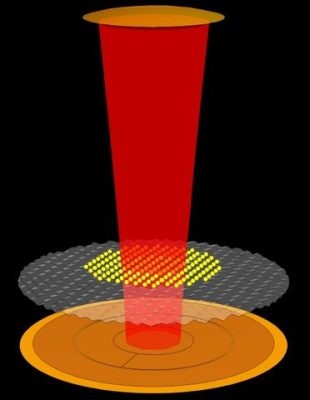Feb 13 2019
The physical world around humans—including modern electronics, the function of which is dependent on the movement of negatively charged electrons—is made up of tiny moving particles. Physicists make efforts to perceive the forces that push such particles into motion, with the aim of tapping their power in innovative technologies.
 The Quantum Dynamics Unit traps a 2D layer of electrons in liquid helium, held inside a sealed chamber and cooled to nearly absolute zero. Inside the chamber, a metal plate and spherical mirror on the top reflect microwave light (the red beam), and thus form a microwave cavity (resonator). The trapped microwaves interact with the electrons floating on the liquid helium. (Image credit: Okinawa Institute of Science and Technology Graduate University)
The Quantum Dynamics Unit traps a 2D layer of electrons in liquid helium, held inside a sealed chamber and cooled to nearly absolute zero. Inside the chamber, a metal plate and spherical mirror on the top reflect microwave light (the red beam), and thus form a microwave cavity (resonator). The trapped microwaves interact with the electrons floating on the liquid helium. (Image credit: Okinawa Institute of Science and Technology Graduate University)
For example, in quantum computers, a fleet of accurately controlled electrons is used to perform colossal computational tasks. In the recent past, scientists from the Okinawa Institute of Science and Technology Graduate University (OIST) showed how a light form, known as microwaves, minimizes the movement of electrons. The study outcomes could help enhance quantum computing.
Since normal computers run on the binary code of zeros and ones, the type and volume of information that can be processed by these machines are limited. The ability of subatomic particles to occur in more than two discrete states enables quantum computers to harness electrons to compress the complex data and carry out functions at breakneck speed. In order to maintain the electrons in limbo, researchers trap the particles and subject them to forces that modify their behavior.
In the new research, published in Physical Review B on December 18th, 2018, OIST scientists captured electrons in a frigid, vacuum-sealed chamber and exposed them to microwaves. The light and the particles modified each other’s movement and energy exchange occurred, indicating that the sealed system could possibly be used to store quantum information—a prospective microchip.
This is a small step towards a project that requires a lot more research creating novel states of electrons for the purpose of quantum computing and storing quantum information.
Jiabao Chen, Graduate Student, Quantum Dynamics Unit, OIST.
Chen is the first author of the paper, led by Prof. Denis Konstantinov.
Sending Electrons Spinning
Light formed of fast, oscillating magnetic and electric fields has the ability to push around charged matter that it encounters in the environment. When light vibrates at a frequency same as that of the electrons it meets, the particles and light can exchange energy and information. If that happens, the motion of the electrons and light is said to be “coupled.” In case the energy exchange happens more rapidly compared to other light-matter interactions in the environment, the motion is said to be “strongly coupled.” In this study, the researchers made efforts to realize a strongly coupled state with the help of microwaves.
Achieving strong coupling is an important step towards quantum mechanical control over particles using light. This may be important if we want to generate some non-classical state of matter.
Jiabao Chen, Graduate Student, Quantum Dynamics Unit, OIST.
In order to have a clear view of the strong coupling, it helps in isolating electrons from deceptive “signal noise” in their environment, which appeared upon collision of the electrons with adjacent matter or interaction with heat. Researchers have analyzed the effect of microwaves on electrons in semiconductor interfaces—points at which a semiconductor encounters an insulator, thereby restricting the movement of electrons to a single plane. However, semiconductors include impurities that hinder the natural movement of electrons.
Since no material is completely free of flaws, the Quantum Dynamics Unit chooses an alternate solution—isolating their electrons in frigid vacuum-sealed chambers equipped with two metal mirrors for reflecting the microwaves.
Each of the chambers, which are small cylindrical containers known as cells, contain a pool of liquid helium, maintained at a temperature close to absolute zero. Although helium stays a liquid at such a high temperature, any impurities that float within the substance freeze and adhere to the sides of the cell. Electrons that cling to the surface of helium effectively form a two-dimensional sheet. Then, researchers can subject the waiting electrons to electromagnetic radiation, like microwaves, by trapping the light between the two mirrors inside the cell.
This comparatively simple system demonstrated the effect of microwaves on the rotation of electrons—an effect that had not been observed in semiconductors.
In our set-up, we can determine the course of physical phenomenon more clearly. We found that microwaves had significant influence on the movement on electrons.
Dr Oleksiy Zadorozhko, Study Author and Postdoctoral Scholar, Quantum Dynamics Unit, OIST.
Powering Up Quantum Computing
The physicists mathematically depicted their findings and discovered that the impact of the fluctuations in the location, speed, or overall charge of individual electrons on the strong coupling effects was negligible. Rather, the average movement of microwaves and particles, together, seemed to activate an exchange of energy and information between them.
The scientists believe that in future, the liquid helium system will enable them to gain accurate control over electrons, thus allowing them to read, write, and process quantum information analogous to the way standard data are stored on a hard drive. With improved insights into this system, the Quantum Dynamics Unit hopes to enhance upon the industry standard for qubits, or quantum information bits. Their attempts could result in the development of faster, more robust quantum technologies.